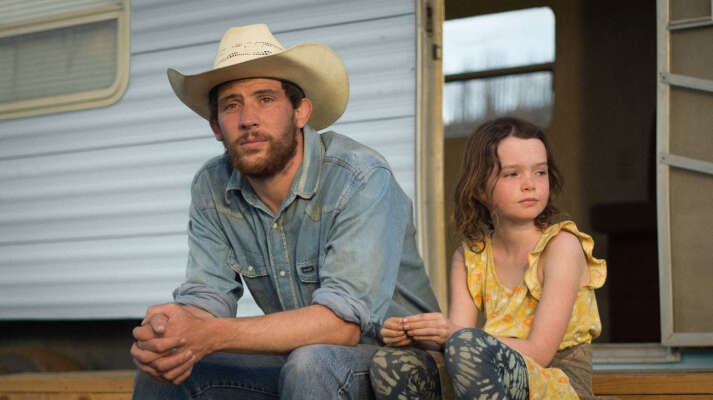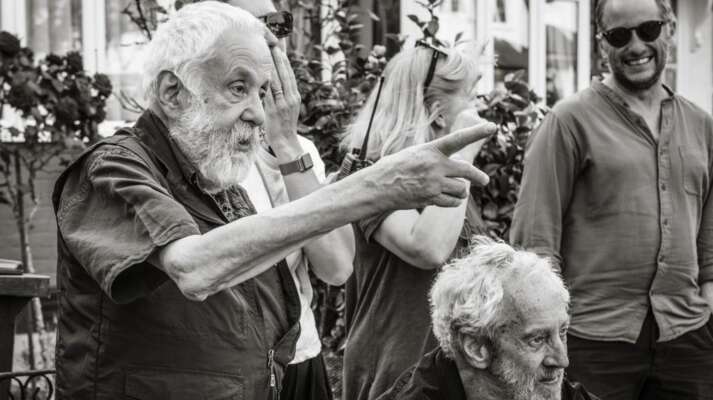Women In Charge
From Elizabeth to EYE IN THE SKY
Women In Charge
Written by Peter Bowen
EYE IN THE SKY | Getting The Job Done

In Gavin Hood’s EYE IN THE SKY, Helen Mirren plays Colonel Katherine Powell, a UK officer spearheading a drone operation in Kenya in the hopes of capturing a British national who has become a terrorist. When new information pushes the operation from capture to kill, Powell’s responsibilities escalate. Not only must she navigate the complex legal and political questions raised by a mission with the very real possibility of collateral damage, but she must direct US pilots based in Nevada to successfully complete the attack. It is a role whose character must project a commanding authority and singleness of purpose. Screenwriter Guy Hibbert had originally written Powell as a man, but Hood convincingly argued that there is both historical precedent for making Powell a woman and the need to address a topic that affects everyone. “I really felt that the film would appeal strongly to both men and women,” explains Hood. “And I didn’t want it to seem like just a war movie for men.” Although Mirren had never played a soldier before, her resume for playing tough, powerful women is extensive. From Prime Suspect’s DCI Jane Tennison to the title character in The Queen, Mirren has repeatedly played commanding characters ready to do what has to be done, a quality that attracted Hood to her in the first place. “She’s ferocious, determined, highly intelligent and completely grounded,” exclaims Hood. “She has real acting chops and the grit you need to play this character.” To understand Powell’s unique place as a woman in power, Mirren researched the reality of military life today. “I wanted to have an understanding of my character’s trajectory by talking about the kinds of experiences she must have had and the things she would have overcome as a woman in the military,” Mirren explains. To celebrate this unique role, we showcase five other memorable films that put women in control.
The Queen | A Crowning Achievement
Before Helen Mirren became a colonel in EYE IN THE SKY, she won an Academy Award for playing a monarch in the 2006 docu-drama The Queen. When casting the story about Queen Elizabeth II in the aftermath of Princess Diana’s death, the producers had really only one actress in mind. “She’s just like the Queen,” producer Andy Harries told Cineuropa. “People adore her, and she also looks like the Queen!" Throughout her career, Mirren has played both royals (Queen Charlotte in the 1995 The Madness of King George and Elizabeth I in a 2005 miniseries of the same name) and commanding figures, from detectives, intelligence agents and spies. To play a living monarch, however, Mirren had to understand and humanize her. To find the woman, Mirren read biographies and news accounts, and watched endless documentary footage, from black-and-white newsreels of Elizabeth as a little girl to recent television coverage. But to find the Queen, Mirren had to move beyond the personal to fathom this unique political figure. “She is a symbol,” Mirren told CNN. “But it's a very potent symbol. It's a symbol that carries the history of Britain with it.” Mirren’s ability to capture the personal power and emotional responsibility of representing a nation impressed nearly everyone, including the Queen herself, who invited Mirren to Buckingham Palace for dinner. “Helen Mirren inhabits the role of Queen Elizabeth so thoroughly that her transformation astounds,” exclaims USA Today’s Claudia Puig. “A lesser actress might have been able to pull off the ceremonial persona, but to portray the Queen as multidimensional and human, as Mirren does, projecting steely determination along with vulnerability and confusion, is a masterful accomplishment.” For this achievement, Mirren won an Oscar® as well as a Golden Globe, a BAFTA, and a SAG award.
The Iron Lady | A Steely Determination

Partially inspired by Helen Mirren’s powerful performance in The Queen, producer Damian Jones set off to make The Iron Lady, a bio-pic about the other strong woman of recent British history, Margaret Thatcher. The conservative prime minister who led England from 1979 to 1990 was a fascinating and controversial figure. Although Thatcher was her country’s sole female prime minister, her staunchly right-wing politics often put her at odds with feminists. This contradiction was summed up perfectly by Emma Barnett in The Telegraph after her death: “It is well known that the Iron Lady did not consider herself to be a feminist, but that doesn’t mean she cannot be an icon to all those women who do.” To capture the complex and contradictory nature of Thatcher, however, the filmmaker chose not to review her political legacy, but rather to focus on her unique role as a public servant. “I wanted to explore the idea of what it is like to be a King and to lose your power,” screenwriter Abi Morgan told Film 4. “It opened up wider questions about the notion of power, age – so thematically, the film became something richer than simply a biopic.” Under Phyllida Lloyd’s direction, The Iron Lady begins in 2008 with Thatcher (played by Meryl Streep) as an older woman conversing with the ghost of her dead husband, Denis (played by Jim Broadbent), about the price of milk. Their breakfast chat prompts a series of flashbacks that recount her extraordinary path from being a grocery’s daughter to becoming England’s longest-running Prime Minister. Streep, who described the film to the BBC as “Lear for girls,” focused on Thatcher’s powerful and enigmatic nature: “I wanted to capture what it was that drew people towards her and what it was that made people have a special venom for her as a public figure.” Playing this political powerhouse that people love – and love to hate – was no easy task. For Salon’s Andrew O’Hehir, Streep’s Thatcher “is in many ways a sympathetic and admirable character, a woman of indomitable will, enormous ambition and profound personal convictions. Those qualities are also shown as driving her to sociopathic extremes, and to a megalomaniacal conception of herself as embodying all the noblest British qualities and single-handedly saving the British nation from socialist doom.” With icy precision, Streep portrayed Thatcher’s passion, pathos and power with such depth that she earned her third Academy Award (and her 17th nomination). If Thatcher represented a powerful woman with a complicated relation to feminism, the same cannot be said of Streep, who donated her entire $1 million paycheck for The Iron Lady to theWomen's History Museum.
Courage Under Fire | Women During War Time

One of the first films to deal with Operation Desert Storm, Edward Zwick’s 1996 Courage Under Fire put the actions of a woman soldier front and center. Captain Karen Walden (Meg Ryan), the commander of a Medevac Huey who died while attempting to rescue the crew of a downed Black Hawk helicopter, has been put up for the Congressional Medal of Honor. Historically only one woman, Mary Edwards Walker, has actually received the Medal of Honor; she was recognized for her service as a surgeon during the American Civil War. Lieutenant Colonel Nathaniel Serling (Denzel Washington), an officer bearing the emotional weight of his own military record, has been tasked by the Army to investigate the circumstances around Walden’s death. What follows in Patrick Sheane Duncan’s screenplay is a Rashomon-like mystery in which each person provides a different, even contradictory, eye-witness account. One soldier, Specialist Andrew Ilario (Matt Damon), salutes Walden’s heroism in taking on an enemy tank. However, Staff Sergeant John Monfriez (Lou Diamond Phillips) dismisses her as a coward who attempted to flee the battlefield. "It was the ambiguity that was most fascinating to me," Ryan told the Seattle Times, “Everybody's perceptions of other people are filtered by what they bring to the table, and just the fact of what she was – a woman in combat – colored how these people thought about her." While critics applauded its complex handling of gender and authority, the military itself was less enthusiastic, backing out of cooperating with the film over script issues. “We were planning one of the biggest tank battle scenes put on film since Patton and, suddenly, we had no tanks,'' Zwick told the Virginian-Pilot. “The Department of Defense, I think, was worried about how the Medal of Honor plot was going to be treated.'' The very idea of portraying women in combat had become a political hot potato, although for Zwick the argument is moot since contemporary weapons have dismantled conventional concepts of a battlefield. “With modern technologies, it's a matter of pushing buttons,” Zwick explained. “The peril is behind the lines as much as on the line – in the barracks – anywhere vulnerable to long-range missiles. Women in the military now are increasingly in peril.'' Ryan, who hitherto had been mostly a combatant in the battle of sexes fought in such romcoms as When Harry Met Sally… and Sleepless in Seattle, proved her mettle in capturing both the reality of women in battle and men’s perception of them. “Unexpectedly tough and credible in the role of an embattled helicopter pilot, Ms. Ryan brings the right tricky nuances to the film's several versions of her final battle, and makes each of them look possible,” praised The New York Times’ Janet Maslin.
Zero Dark Thirty | Female Intelligence

For Zero Dark Thirty, Kathryn Bigelow and screenwriter Mark Boal made a woman, a CIA operative named Maya (Jessica Chastain), the central hero of one of the most important military operations of the 21st century – the capture of Osama bin Laden. On May 2, 2011, Bigelow and Boal had nearly finished a script on the failed attempt to capture bin Laden in the Tora Bora Mountains. “The minute we heard the news that Osama bin Laden had been killed, what we had been working on became history,” Bigelow wrote. “As interesting a story as that would have been to tell, the news re-directed our entire efforts. It changed the movie idea forever.” With a new direction, the filmmakers needed a new hero. From extensive research on the CIA’s long campaign to find bin Laden, Boal and Bigelow decided that their new protagonist should be a woman. “I was first of all surprised to learn that women were at the center of this hunt,” Bigelow explained to The Guardian. “And I was sort of surprised that I was surprised. You don't think of a young woman being a terrorist-hunter." Later reports, like No Easy Day: The Firsthand Account of the Mission that Killed Osama by one of the Navy Seals who took part in the raid, pinpointed one operative in particular, an analyst named “Jen,” as spearheading the operation. With nearly no real psychological backstory, Maya assumes a allegorical stature in the film, both portraying the hard realities of being a female agent in the CIA and channeling the anger and frustration of Americans over 9/11. For The Washington Post’s Ann Hornaday, she operates “not just as the audience’s surrogate through a labyrinthine collection of facts, figures, locations and characters, but as the personification of the intelligence and military personnel who, through dint of perseverance and determination, finally got their man.” For Bigelow, Chastain was the right woman for the job: “Jessica’s a brilliant actress, a force of nature. Her innate ferocity, along with a vulnerability that humanizes her character, is a perfect combination.” In taking on the role, Chastain acknowledged what a radical departure Maya represents to film history. “Historically, in movies, lead characters are played by women defined by men, whether it’s a love interest or they’re a victim of a man, and Maya’s not like that,” Chastain told Screenrant. Indeed the Los Angeles Times’ Kenneth Turan noted, “What is most exciting about Maya is that screenwriter Mark Boal…has shrewdly written her less like a heroine and more like an archetypal big-screen hero.” For a story with “no love story. No flag-waving. No politics,” points out Rolling Stone’s Peter Travers, “Chastain is a marvel. She plays Maya like a gathering storm in an indelible, implosive performance that cuts so deep we can feel her nerve endings.” It was a performance for which she won a Golden Globe and was nominated for an Oscar®.
Elizabeth | A Nation Treasure
When Working Title embarked on making Elizabethin 1997, there had been a veritable royal procession of Elizabeths before them. First brought to the screen in 1912 by Sarah Bernhardt, and later embodied by talents as diverse as Bette Davis, Glenda Jackson, Agnes Moorehead and Quentin Crisp, the story of Queen Elizabeth seemed to have little new to reveal. To give it a new angle, the producers turned to Indian director Shekhar Kapur to bring historian-turned-screenwriter Michael Hirst’s script about the early years of Elizabeth to the screen. To make it even more international, Kapur cast the then up-and-coming Australian actress Cate Blanchett to play the lead. Kapur wanted to find the human heart beating behind the historical facts. “I had to make a choice: whether I wanted the details of history or the emotions and essence of history to prevail," explains Kapur. “My main concern was to tell the human story. She was a living, everyday human being – and then she became a queen. We took the icon, and went behind the icon." Blanchett’s performance, however, was haunted by another icon – Princess Diana. "It was incredible to begin filming two days after her death,” Blanchett told The Independent. “The first line of the shoot was 'The Queen is dead. Long live the Queen.’ It was just very odd.” For Blanchett, this contemporary example of a woman suppressing her passions and desires to serve her country provided a powerful tool with which to comprehend the historic Elizabeth. "The film is more a metaphorical thing about what it means to be queen,” explained Blanchett. “It's about what happens in public to the private self, and the melding of the heart and the head when there are not only political expectations but political ambitions… I think it's similar to what happened to Diana." While some historians quibbled about the film’s accuracy and its lusty portrayal of the young Elizabeth, most critics were enthralled by Blanchett’s commanding performance. “Alternately gaunt and angular and ethereally beautiful, Blanchett conveys with grace, poise and intelligence that Elizabeth was a wily, decisive, advanced thinker, far too aware of her own exceptional nature to bow to any man,” applauded David Rooney in Variety. Others joined in this praise. Blanchett went on to win a Golden Globe as well as be nominated for an Oscar® for her performance.




